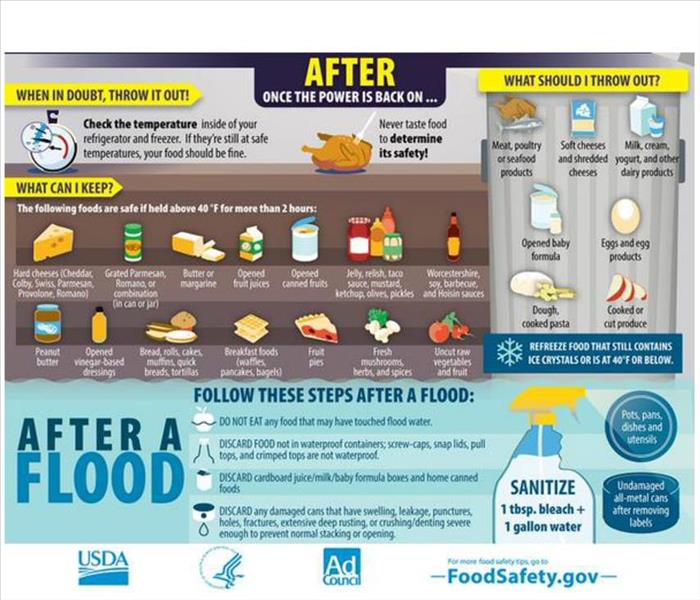Safe Handling of Food and Utensils After a Disaster
7/6/2016 (Permalink)
Safe Handling of Food and Utensils After a Disaster
Julie Garden-Robinson, Food and Nutrition Specialist
Food contamination may be a problem after a flood, tornado or fire. Floodwaters may carry silt, raw sewage, oil or chemical wastes. Filth and disease bacteria in floodwater may contaminate any foods the water touches, making them unsafe to eat. Fire may cause food contamination from exposure to heat, smoke or chemicals.
Handling Food Following a Flood
Examine food carefully after a flood. Contamination may occur if floodwaters have covered, dripped on or seeped into the food. Some foods may be protected by their containers. If you have any doubt about the safety of a food, it is always better to throw it out rather than risk disease.
The following guidelines will help you decide when to throw out foods and how to disinfect foods that can be saved.
Do not try to save the following foods if they have come in contact with floodwater:
- Fresh produce from your garden, such as lettuce, cabbage and potatoes. In some situations, immature root crops may be safe if you do not harvest them for at least two weeks after the floodwaters recede. To be safe, however, have your local Extension office or health department test the garden soil for harmful bacteria.
- Containers of nuts, spices, seasonings and flavorings.
- Canisters or bags of grains, sugar, salt, coffee and tea.
- Paper, plastic, cloth, fiber or cardboard boxes of food.
- Plastic bags of food, even if boxes and containers inside the bags seem dry. These include pastas, cereals, rice, dried milk, crackers, cookies or mixes.
- Screw-topped or crimp-topped jars or bottles of food that have been touched by floodwaters, even when jars have not been opened. This includes all home-canned foods in glass jars and bottles as well as all jams, jellies, honey, molasses, syrups, fruits, pickles, etc., in glass jars. There is no lid in use on glass food containers that will keep out water if the container is immersed.
- Porous non-food items that are used with food or put into the mouth, and items made of hard rubber, plastic or other flexible (porous) materials, such as baby bottle nipples, pacifiers, and plastic or wooden dishes and utensils.
Disinfecting Food and Utensils After a Flood
Cans of Food. Cans that do not have dents or rust can be saved if they are handled properly before they are opened:
- Remove labels. Use a permanent marker to immediately re-label each can.
- Wash the cans in a strong detergent solution with a scrub brush to remove all silt.
- Immerse scrubbed containers completely in a lukewarm solution of chlorine for one minute. See directions in table below for making a chlorine disinfecting solution.
- Remove containers from the chlorine solution. Allow to air-dry before opening. Re-label with the permanent marker, if necessary. Use as soon as possible because containers may rust.
Dishes and Utensils. Glass, ceramic and china dishes, metal and glass cookware, glass baby bottles and empty canning jars can be saved in the following way:
- Thoroughly wash them in a strong detergent solution, removing all filth and mud.
- Disinfect china and glass dishes in a chlorine solution in the strengths described in the table below.
- Disinfect metal pots, pans and utensils by boiling in water for 10 minutes.
Handling Food Following a Fire
Use extreme caution when trying to save food after a fire. Food and utensils damaged by heat, smoke and chemicals or water used to fight the fire may not be safe to use. The following guidelines will help you decide which foods to throw away and how to disinfect those that can be saved:
- Treat food items and utensils exposed to water used in fighting the fire as though they had been exposed to floodwaters. Throw away or wash and disinfect.
- Throw away any food items that were charred or near the fire. Heat damage may not be apparent on the outside of canned goods, but extreme heat can harm the contents. Throw them away.
- Throw away all food in paper, plastic, cloth and cardboard containers, and screw-topped jars and boxes that were exposed to smoke or chemicals used in fire fighting. Disinfect cans that are free from dents and rust, glass, ceramic, china and metal dishes and cookware.
Handling Food Following Chemical Exposure
Food and utensils can become contaminated by chemicals used in fire fighting or from other sources. Broken bottles or aerosol cans that contain pesticides or household cleaning items also can cause food contamination. If you suspect chemical contamination:
- Throw away all food in paper, plastic, cloth and cardboard containers and screw-topped jars and bottles that were exposed to the chemical






 24/7 Emergency Service
24/7 Emergency Service
